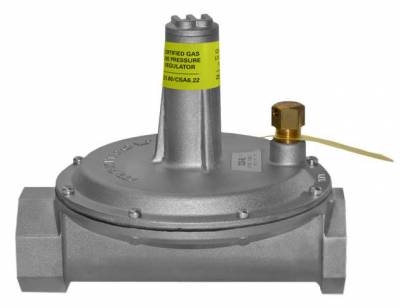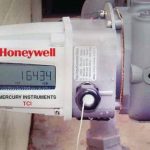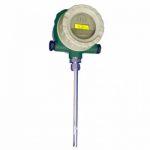Venting Gas Regulators | Overpressure Protection Devices for Appliances
When the gas line pressure to an appliance exceeds the appliance’s combination-control-valve maximum input pressure, how can we reduce the line pressure to the device and meet the International Fuel Gas Code regulations?
Problem: Line Pressure Exceeds Appliance Regulator Maximum Input
A customer has installed an appliance deep within a building. The gas line pressure to the appliance is 15 PSI, which is higher than the maximum allowable operating pressure (MAOP) of the appliance combination control valve. The line pressure to the device needs to be reduced to pass inspection.
Venting of Regulator Solutions
Based on the International Fuel Gas Code regulations, there are two ways to reduce the line pressure to the appliance to solve the customer’s problem.
- Install a regulator at the appliance. This placement will require that you run a vent to an exterior wall of the building. Depending on where the appliance is, it can be expensive and unsightly.
- Install a series regulator manufactured in the U.S. with an approved device called a vent limiter, which reduces the pressure to the rated inlet pressure of the appliance.
Both of these approaches are approved in the 2015 International Fuel Gas Code 410.3.
410.3 Venting of regulators. Pressure regulators that require a vent shall be vented directly to the outdoors. The vent shall be designed to prevent the entry of insects, water and foreign objects.
Exception: A vent to the outdoors is not required for regulators equipped with and labeled for utilization with an approved vent-limiting device installed in accordance with the manufacturer’s instructions.
Overpressure Protection Devices
If the building’s gas line pressure from the meter is between 2-5 PSI, overpressure protection devices (OPD) must be installed. The IFGS has various requirements on pressure limitation requirements.
Pressure over 14 inches w.c. If an application’s piping system to the appliance exceeds 14″ w.c., refer to 416.2.2.
416.2.2 Pressure over 14 inches w.c. Where piping systems serving appliances designed to operate with a gas supply pressure greater than 14 inches w.c. are required to be equipped with overpressure protection by Section 416.1, each overpressure protection device shall be adjusted to limit the gas pressure to each connected appliance as required by the appliance manufacturer’s installation instructions.
Pressure under 14 inches w.c. The balance of this discussion will pertain to gas line pressure piping between 2-5 PSI serving appliances with MAOP of 14″ w.c. There are several ways to prevent the pressure from ever exceeding the MAOP of the gas appliance or achieve overpressure protection.
Relief Valve
- A relief valve can be built into the regulator. At that time, the regulator must be vented to an outside wall, and the installer must ensure that the vent line’s size is following the manufacturer’s instructions. The vent line must be at least the size of the opening out of the regulator (or larger).
- A separate relief valve can be used following the same conditions, that a vent line must be run to the outside wall outside and be the proper size. Additionally, there can be no valve between the downstream gas line from the regulator to the appliance.
Monitor Regulator
Series Regulators
A series regulator is installed upstream from the line regulator and set continuously to limit the pressure on the inlet of the line regulator to 14″ w.c. MAOP.
Maxitrol Regulator and Vent Limiter

Maxitrol has designed series regulators that are built in accordance with the International Fuel Gas Code. The 325 Series regulator with a vent limiter will reduce the pressure to the rated inlet pressure range of the gas appliance regulator.
Maxitrol has designed series regulators that are built following the International Fuel Gas Code. The 325 Series regulator with a vent limiter will reduce the pressure to the rated inlet pressure range of the gas appliance regulator. The 325 must be installed at or near the appliance. For more information, visit Maxitrol Appliance Pressure Regulator and Vent Limiter.
Reference
- Chapter 4 – Gas Piping Installations – INTERNATIONAL CODE … (n.d.). Retrieved from https://publicecodes.cyberregs.com/icod/ifgc/2009/icod_ifgc_2009_4_sec010.htm_br
- Maxitrol Natural Gas Regulators | 325 3 Line Pressure. (n.d.). Retrieved from https://www.lincenergysystems.com/measurement-control/itron/line-pressure/item/154-maxitrol-325/154-maxitrol-325_br



Natural gas is a non-renewable source of energy and is a fossil fuel like petroleum. It is essentially composed of methane, which is a hydrocarbon. Before processing, it may have other hydrocarbons, such as butane and propane. Natural gas is odorless and it is therefore required by law to add an odorous substance to help detect it in case of leaks. Usually Mercaptan is added, which gives a pungent smell.
I have a 5# nat. Gas system delivering 8″wc to cooking appliances . Do they make a line pressure regulator that has the o.p.d. built into the regulator. Never seen or heard of such before. All that I’ve seen have been external and factory tied to the regulator. I’m being told the regulator that is installed has one? Steve
I like your blog that you mention here. Really, entire discussion is more helpful and all the tips are more effective too. I am very glad to go through this kind of helpful article. You are provided such a nice and great article within this.
Over Pressure Protection Device